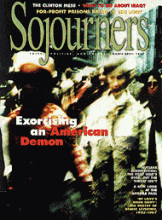"THIS IS the face of Maria. She's always in trouble and she has a hard time doing the right thing," the 12-year-old girl mumbles as she displays a sketched self-portrait to the class.
"This is me, Ernesto," an adolescent boy pipes up confidently. "He likes soccer and he's really good at it."
Maria and Ernesto are in the classroom of the Santa Cecilia barrio, a Christian base community in San Salvador, El Salvador, for a session of art therapy offered by the Astac Cultural Center. The teacher concludes the lesson by asking the children to take their pictures with them and search for the positive attributes behind the faces.
El Salvador's youth are suffering from a lack of identification with their roots and culture. Not only do they seldom reflect upon a civil war that ended less than a decade ago, they are living in a country that is more violent now than during that 12-year conflict.
I spent the summer of 1997 working with deported members of Los Angeles street gangs in El Salvador through a program called "Homies Unidos." With the support of Save the Children, Homies Unidos is a group of non-active gang members, mostly from the rival groups "Mara Salvatrucha" and "18th Street," who are working to educate themselves and others on violence prevention and job creation. My project focused mainly on the reintegration of deported gang members into Salvadoran societya society as foreign to them as to me, since they were refugees in the United States during the war.
EL SALVADOR IS RANKED among the most violent nations in Latin America, with more daily assassinations now than during the war. The tiny nation ties with South Africa for the highest number of murders per capita. An average of 150 people per month deported back to El Salvador (including many gang members with criminal records), combined with overpopulation and economic and environmental strains, fuels El Salvador's spiraling cycle of violence.
Read the Full Article
